When a usurper cuts down the queen and proceeds to spread a dark empire over the continent, you must take control of the exiled prince Alain as he seeks to liberate the people and enact justice. A Tactical RPG that combines large-scale strategy battles with real-time elements and unit management, the game brings a classic playstyle into the modern era. Gather an army to bring peace to the kingdoms of Fevrith and become the Unicorn Overlord!
Release Date: March 8th, 2024
Available Systems: Nintendo Switch, PlayStation 4/5, Xbox Series X/S (current at time of writing)
Developer: Vanillaware
The Light in the Darkness
In leading Alain on this campaign against tyranny, the first thing that struck me was how vast the game truly is. The kingdoms of Fevrith are each large in their own right, with towns and forts populating the landscape in need of your assistance. Of course, you can't have an RPG without being waylaid with additional content, as well: side-quests, optional challenge maps, the colosseum, mining for treasure, and various other opportunities help create a world that's full of interesting stories. If you want to charge forward through the story you can - if you've got the goods you can even go straight to the final boss - but there's so much you would be missing out on in the process. The game boasts about 180 quests to complete of various sizes, with 70 unique characters to recruit (plus up to 64 generic mercenaries should you require a larger army). Each of them have a tale to tell, if only you take the time to listen.
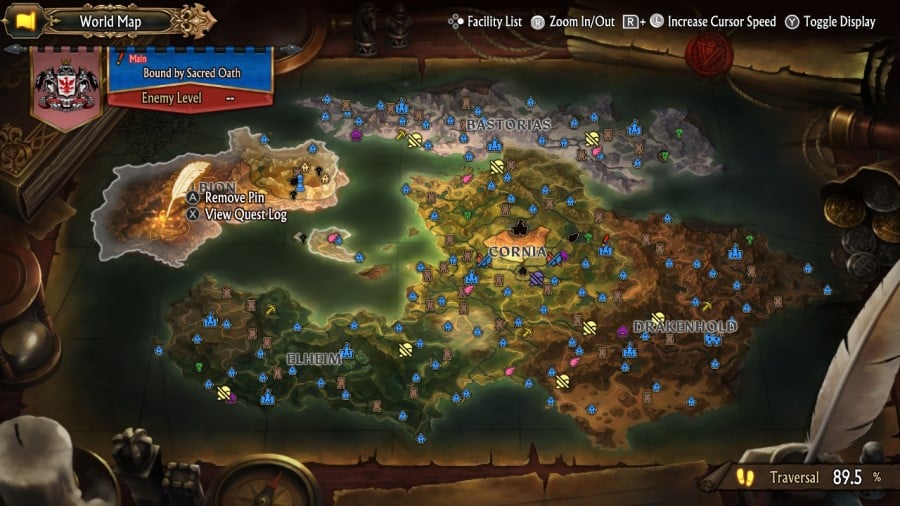
You see, it's not always enough to simply defeat your enemies: a great leader knows when to demonstrate their power, and when to show mercy. At periods throughout the campaign, choices will have to be made that can influence the story and change the battlefield. A character might join the Liberation Army should you make the right decision...or they could end up walking away entirely. They might end up dying, lost forever. This is a war, after all; wars bring consequence. For the most part I enjoyed this system, minus one very large exception (more on that later): recruiting people you weren't expecting helps build your roster in a practical sense, but also expands upon the lore of the world. Several characters could be a little too liberal with spouting their life story in the name of defending their actions, but I wouldn't hold that against the writing; I found it more amusing than anything.
The storytelling doesn't stop once they're on your team, either. By using characters that share a relationship in the same group, you could build their Rapport and get additonal snippets of character-building. I loved this because it encouraged me to put friends or family on the same unit, which - while not necessarily optimized - added more flavor and dimension to the proceedings. They weren't just fighting for Alain, but for each other and for a better tomorrow together.

Of course, you could cheese this process by just paying gold for meals, which offers way more Rapport than you can get through combat. However, I found building it naturally over time felt more "real", even if again it wasn't the most optimized way of doing things. That and I had other uses for my gold: I've got a war to win, after all!
Blades Shining Bright
Liberating a continent and overthrowing a tyrant requires more than the power of friendship, no matter what some JRPGs might lead you to believe. Wars are often won or lost in the preperation you make beforehand, and Unicorn Overlord is no exception. Thankfully, the game has a very deep system for customizing your units, as well as the characters themselves. Units can hold up to 5 individuals at a time in a 2x3 space, but how they're positioned can determine the way they (or enemies) will behave. For example, your natural inclination might be to place your healers in the back row with your tanky fighters up front, but if you put the healer directly behind the fighter it might get hit by attacks that target a column. Or, if you have too many characters in the back with only one in the front row, enemies might try to use their "Row with 2+ combatants" tactic to bombard the back end, ignoring the more durable characters. Learn from your enemes and their tactics, to know how best to defeat them!
On a more individual level, characters can be outfitted in a variety of ways. There are about 25 classes to consider, with some only available to unique people. Class determines what skills they'll learn and what they'll be able to equip, but beyond that it's totally up to you how you want them to operate. This functionality larges comes down to their Tactics, which are the rules the character will follow to determine what actions they take. It's important to note that you do not have direct control of their actions: when two armies come together and a fight begins, the combat plays out automatically, with the Tactics informing the flow of battle. I've included an example below, of Eltolinde the Elven Sibyl:
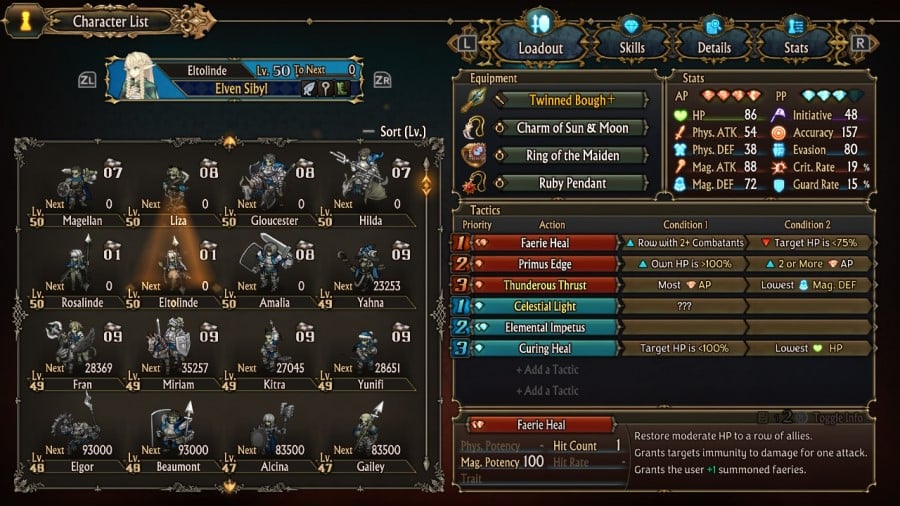
Based on her priorities, with more important skills being up top, Eltolinde knows she must first attempt to use Faerie Heal if a group of friendly combatants are too damaged. If they are not (or if her AP is too low to use a 2-AP ability), she'll default to the next skill, which is the attack Primus Edge. Red skills are Active abilities that require the character to take their turn, while blue skills are Passive and trigger when their conditions are met. By rearranging these Tactics, I can influence how Eltolinde will behave when a fight breaks out; changing her gear can introduce new skills into the mix, as well, giving her more options. For example, Thunderous Thrust is an attack that comes from her weapon, the Twinned Bough.
"That's all well and good, Sera, but how do you actually play the missions?!" Don't worry, I'm getting to it! With your army well-equipped and ready to engage the enemy, the next step is to lead the charge and win the war, right? Well, there's a bit more to it than that. After learning your objective, it's time to deploy your units and take it to the enemy. Strategy is key in this tactical game (duh), as you need to strike out and take objectives while also defending your territory. Missions play out in "real time with pause", allowing you to stop the action long enough to activate Valor abilities or use consumables.
Several things can influence the flow of a battle, from what kinds of soldiers make up enemy units, to how the battlefield is positioned and what populates it, such as catapults or barricades. What abiltiies you have available to you are based on each unit's makeup, with the Leader being the one that determines things like mobility and whether or not they can support other units in a fight with arrows or magic. I found flying Leaders to be particularly strong in this game, as you could simply fly over walls and grab a fort without bothering with its natural defenses. Knights were strong contenders for a Leader position, too, with their high mobility allowing them to plow through battles quickly. Stamina was another factor, as each unit can only engage in so many fights before they become tired (as noted by the numbers next to them). Winning a battle meant using more than just the same powerful unit over and over; you need to rely on your entire army!


As stated before, the fights are automatic once two opposing units come together: the game even tells you ahead of time the exact outcome, providing you knowledge of your victory or defeat. It's then up to you to hedge unfavorable outcomes by switching to a different unit, adding in support, or activating Valor abilities. Watching the fights was enjoyable, but knowing exactly how they would play out cut into my interest a bit - you could just as easily skip them for the same result, meaning you were only watching for your own amusement. Towards the game's end, I found myself skipping through the vast majority of fight animations, only playing out the ones that featured unique characters so I could listen to the dialogue. And it's here where the crux of the issue begins to reveal itself.
Fade to Black
Unfortunately, Unicorn Overlord began to wear on me as I continued. I wasn't unhappy with the experience: there's just so much there, and I had become so powerful by the end of the second kingdom that the challenge was beginning to fall away. This could be my own fault; there are four difficulties starting out, those being Story, Normal, Tactical, and Expert. I chose Tactical, and I probably should have picked Expert. I reached a point where I was essentially going through the motions to see the story content, because victory was almost guaranteed. I started skipping fight animations, bypassing dialogue because I could read faster than they could say it, and overall I was just waiting for the game to end.
My units reached a level of strength and gear-power that they could instakill anyone they touched, save for being hard-countered; even then they would still win, just suffering some damage in the process. The second mission screenshot above with Hilda's unit is a good example: she's gonna take 164 damage, which was quite high at that time in the game, but she was still doing 983 to them. A couple potions to heal up and she could go back to dominating the battlefield. The image below is another one, despite only being an attack against a single soldier: that swordmaster had no hope of surviving Leah's Meteor Slash, and just from looking at each side's respective stats you could tell how much more superior mine were. I destroyed the final boss in a single engagement, which should tell you everything right there.
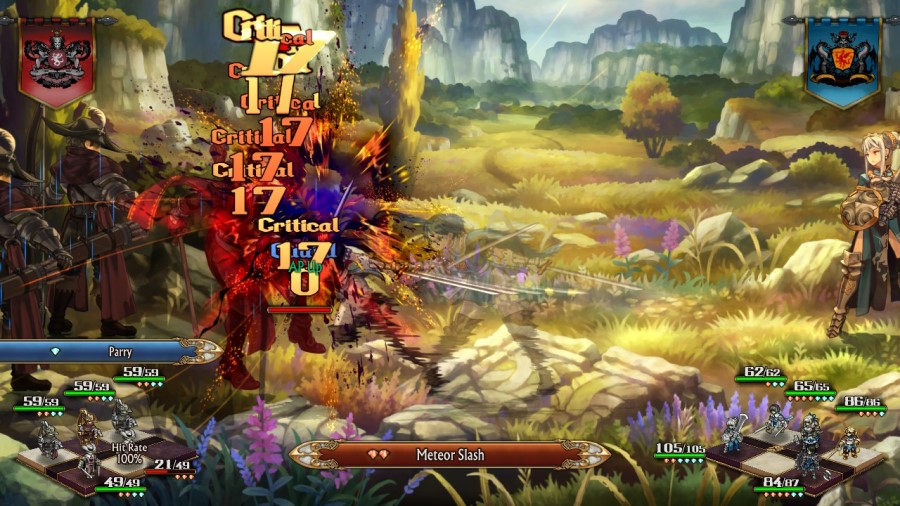
This leads right into my final complaint, which naturally is a spoiler. You have been warned.
When you defeat Emperor Galerius, assuming you did everything up to this point in the game that you were supposed to do, you are offered a final choice. If you choose correctly, the game will lead into one last confrontation that you'll no-doubt win, the game will end happily, and you'll have the option to enter postgame. If you choose incorrectly, or fail to do all the required content, the game will end on the spot with a Bad Ending. Everything you did up to that point will have been meaningless, and the stupid part is that the twist is only explained after you've made your decision. If you pay really close attention to the plot points about how Zenoira is trying to resurrect a dead empire by possessing the current population, you can perhaps guess the twist; I was paying attention, or at least thought I was, and still didn't call it. This could naturally lead into a full discussion on the nature of binary endings, and how having a final decision shoved at you right at the end can undermine the story up to that point, but I'll save that for another time. The end result is still the same, spoiling what was otherwise a perfectly solid - if sometimes cliche - fantasy war story.
Conclusion
All of that being said, I still enjoyed Unicorn Overlord. It was entertaining, and certainly doesn't lack for content. My playthrough lasted 75 hours! Had I chosen a higher difficulty I might have been challenged for longer, thus prolonging any sense of disappointment I started feeling towards the back-end. The gameplay itself is still really strong, albeit possibly too complex for players who don't frequent the genre, but I certainly recommend the experience to fans of strategy games.
Just don't expect a PC release: Atlus' deal as publisher did not include a port to Steam and the like, nor any form of DLC. A survey was produced to gauge the interest in a sequel, and that did well, so there's hope for more unicorns and/or overlords in the future.
Are you interested in picking up Unicorn Overlord, or have you done so already? What do you think of the game? Did you find it challenging enough? Let us know in the comments below!
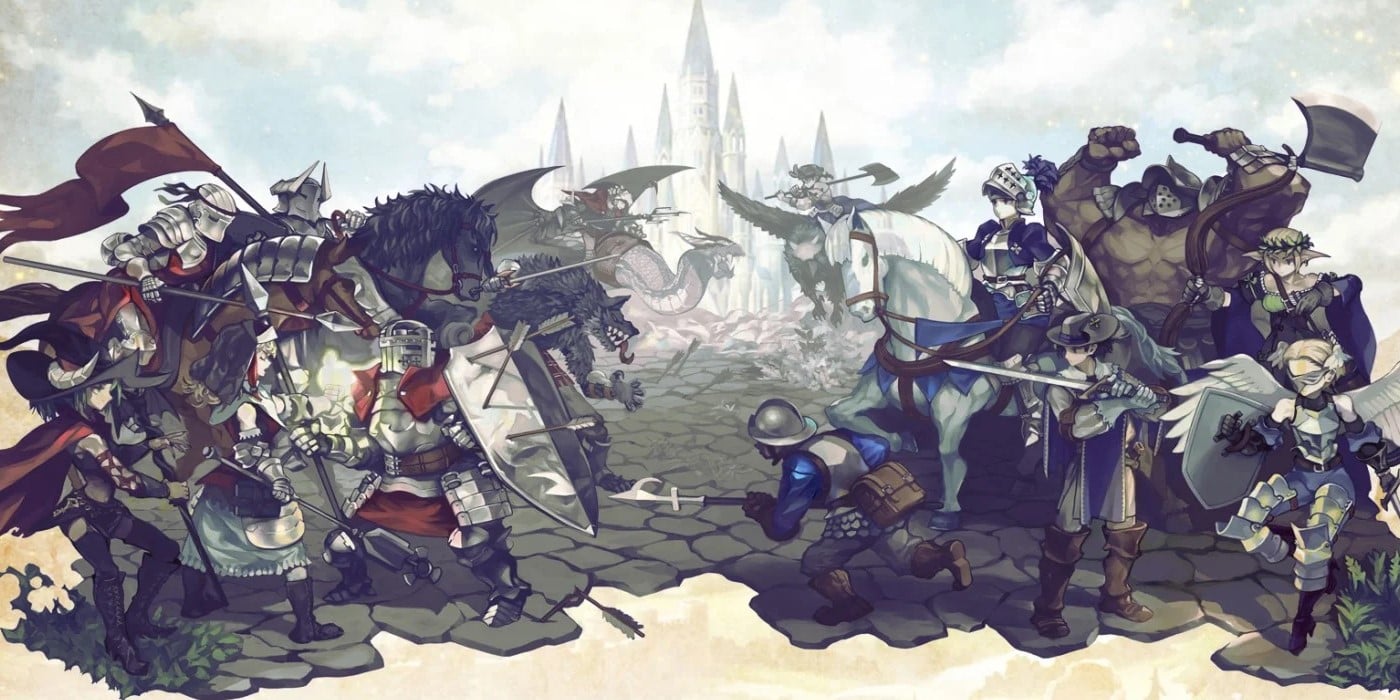
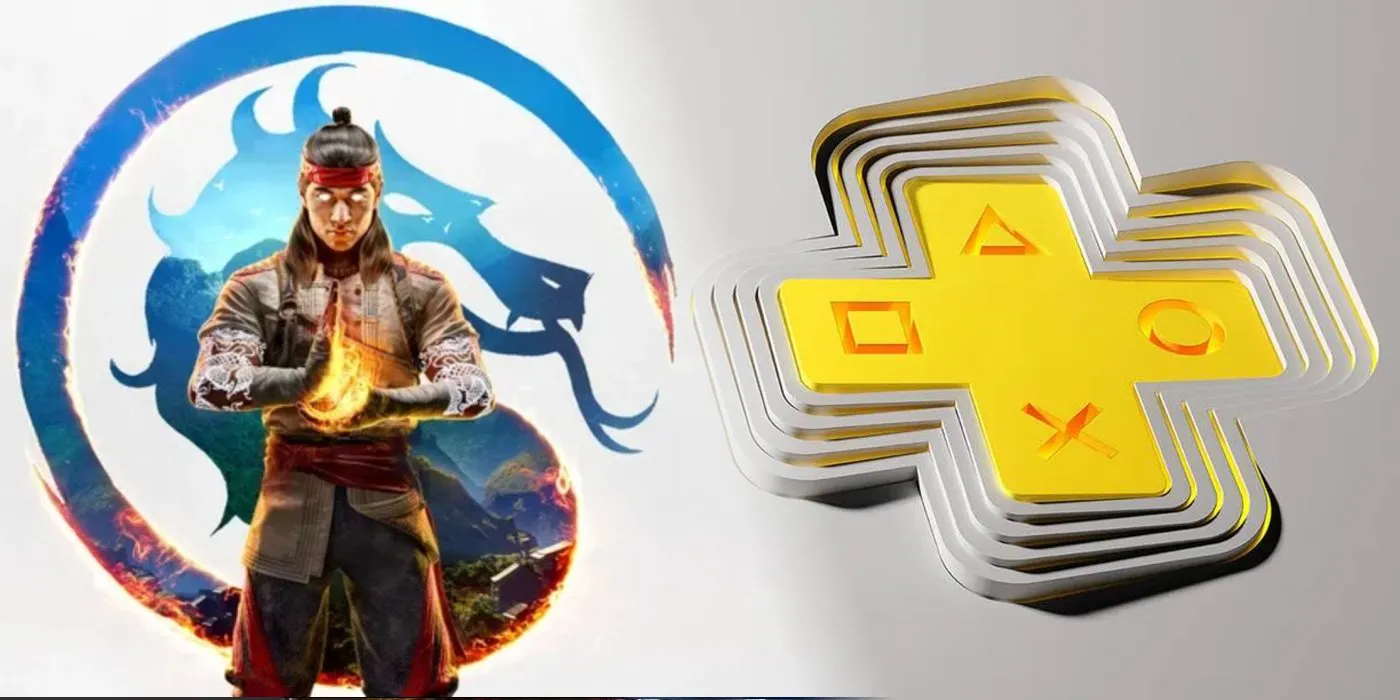
Comments
I played quite a lot of Atlus' Ogre Battle on SNES back in the day, and also VanillaWare's Odin Sphere years later. I can totally get those games experiences not being for everyone but they had a well thought out and interesting style of their own that I appreciated so I think I have to check this one out sometime - thanks for the review!
Thanks for reading it :D I think I remember playing Ogre Battle - didn't that have Tarot cards you could collect that did...things? It's been a long while: I was like 5, playing it at a babysitter's house lol.
I love Tactics Ogre too, but that has different gameplay. Tactics Ogre Reborn is so long I had to take a break from it after 96 hours on a single Steam playthrough. Still haven't finished the main story D: Will have to go back and finish it at some point!